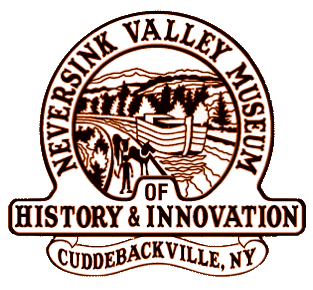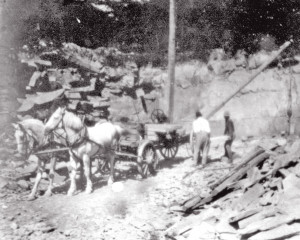Draught Animals
As the 19th century opened, the energy used for moving objects from one place to another was still muscle power. In America, draught animals such as horses, mules and oxen supplied the power needed on the farms, canals and roads of our young nation.
Oxen helped open up the vast Catskill wilderness and were essential to the tanning industry, the Catskill’s most significant industry at the time. Early in the 19th century, turnpikes began to be built in the lower Catskills. The greatest of them all, the Newburgh-Cochecton Turnpike, was chartered in 1801 and completed in 1808. This road cut across Sullivan County from Bloomingburg on the Orange County border to Cochecton on the Delaware River and opened for settlement the area it crossed. Ox-drawn sleds were better suited to the rough roads being cut through the wilderness than were horse- or oxen-drawn wagons and helped advance the settlement of the Catskills.
In clearing the forested and rocky land the Newburgh-Cochecton Turnpike passed through, many large rocks and tree stumps needed to be removed. Oxen are stout animals and are well suited to the laborious task of clearing land for farming. It’s not surprising, then, that the lower Catskills was a leader when it came to working oxen. Of the 62 counties of New York State, the three lower Catskill counties of Delaware, Ulster and Sullivan had roughly 13,000 working oxen in the mid-1800’s and ranked amongst the top 10% of New York counties with the greatest number of working oxen.
Oxen and mules were vitally important to the Catskill tanning industry of the mid-1800’s. The animals would carry the hides brought to the area on D&H Canal boats to the tanneries and would carry the finished leather back to boats for shipment to New York City. They were also important in carrying the large amount of hemlock bark needed in the tanning process from the depths of the forest to the vats of the tanning factories.
The turnpikes opened the way for stage coaches to carry people into and out of the Catskills. Monticello was founded by two brothers, Samuel F. Jones and John Patterson Jones in 1804 as a village on the Newburgh-Cochecton Turnpike. It was chosen county seat in 1809 when Sullivan County was created from part of Ulster County because of its location on the turnpike. Before 1871 when the Port Jervis & Monticello Railroad was completed through the Neversink River valley, travel to Monticello was by foot or horse. As county seat, traffic to the village was brisk and stage coaches were a frequent sight.
Horses were generally changed every ten or 12 miles on overland stage coach routes. Since the trip from Monticello to Newburgh was almost 50 miles long, the teams of horses pulling the stage coaches would have been changed about three times during a journey. Horse-drawn freight wagons could also be seen on the Newburgh-Cochecton Turnpike carrying provisions from Wurtsboro on the D&H Canal and Newburgh on the Hudson. The demand for working horses was increasing year by year and by 1865 there were more horses in Sullivan County than there were oxen.
Horses and mules were critical to the D&H Canal. Whilst the smaller canal boats in use during the early days of the canal only required one horse to pull them, after the last canal enlargement the canal boats were so large that they required teams of two or three horses or mules to pull them along the canal. Since mules were hardier, had greater stamina and were calmer than horses, mules gradually supplanted horses on the canal. It was also claimed that mules were cheaper to maintain than horses and this became a further reason for the increase in the use of mules.
The teams pulling the canal boats plodded along the towpath ridden or led by tow boys or girls. Some of these children were orphans and there are stories about mules being more valuable than the orphan children. The mule team would have to walk close to the edge of the towpath at times and were thus in danger of slipping and falling into the canal. If a mule should fall into the canal with its young rider, for example, the story goes that the animal would be fetched from the water before the child, since replacing the animal would cost money but the orphan was easily replaceable without any cost to the boat captain.
Sometimes, through no fault of their own, tow animals would fall into the canal when the towpath bank would suddenly give way. However, it appears that horses were more prone to accidents. Horses are more sensitive than mules and there are many stories about horses being frightened by lightning, panicking and falling into the canal. There are even stories about horses being spooked by clothes flapping on a clothesline and bolting, only to slip and fall into the canal.
The canal way was dotted with mule and horse barns and shelters along its entire length. These establishments provided various services to the draught animals who worked the canal. Many horses and mules were owned by the boatmen and stayed with them throughout their career on the canal. Other animals were owned by the D&H Canal Company and would not necessarily be used by the same boat captain from year to year.
When the canal closed at year-end for the winter months, the horses and mules would frequently be boarded with local farmers in the area where the canal boat was tied up. This would usually be near Honesdale or Rondout. The horses and mules generally received good care in their winter quarters and were well looked after.
As the 19th century drew to a close, the era of the draught animal was ending. Steam railroads were supplanting the canals and the first motor cars were starting to appear on America’s roads. Muscle power was being displaced by fossil fuels. Vast coal fields were providing fuel for steam engines and the petroleum economy was looming on the horizon after the first successful well was completed in 1859 at Titusville, Pennsylvania.
Copyright 2010 by Stephen Skye
Short Link:

